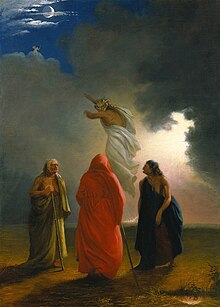Our website is made possible by displaying online advertisements to our visitors.
Please consider supporting us by disabling your ad blocker.
Three Witches
| Three Witches / Weird Sisters | |
|---|---|
| Macbeth character | |
 Scene from Macbeth, depicting the witches' conjuring of an apparition in Act IV, Scene I. Painting by William Rimmer | |
| Created by | William Shakespeare |
The Three Witches, also known as the Weird Sisters, Weyward Sisters or Wayward Sisters, are characters in William Shakespeare's play Macbeth (c. 1603–1607). The witches eventually lead Macbeth to his demise, and they hold a striking resemblance to the three Fates of classical mythology. Their origin lies in Holinshed's Chronicles (1587), a history of England, Scotland and Ireland. Other possible sources, apart from Shakespeare, include British folklore, contemporary treatises on witchcraft as King James VI of Scotland's Daemonologie, the Witch of Endor from the Bible, the Norns of Norse mythology, and ancient classical myths of the Fates: the Greek Moirai and the Roman Parcae.
Shakespeare's witches are prophets who hail Macbeth early in the play, and predict his ascent to kingship. Upon killing the king and gaining the throne of Scotland, Macbeth hears them ambiguously predict his eventual downfall. The witches, and their "filthy" trappings and supernatural activities, set an ominous tone for the play.
Artists in the 18th century, including Henry Fuseli and William Rimmer, depicted them variously, as have many directors since. Some have exaggerated or sensationalised the hags, or have adapted them to different cultures, as in Orson Welles's rendition of the weird sisters as voodoo priestesses.
Previous Page Next Page


